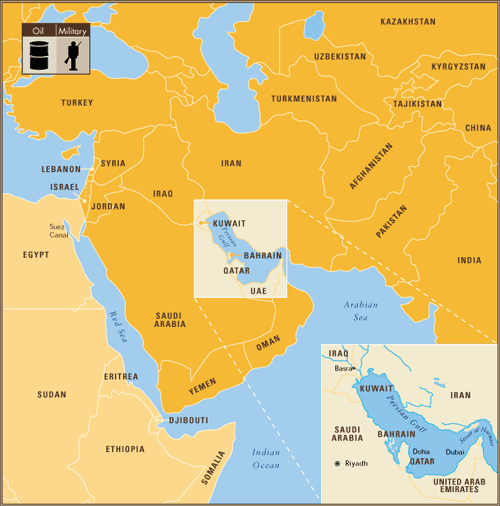Click on the Oil Can Icon for information on the gulf region’s oil economy. Click on the Military Icon for information on the U.S. military presence and investment in the region.
After clicking on either icon, you can see detailed information by clicking on each country. (Note: this feature is not accessible when using Internet Explorer 5.0 for Macintosh)

Data research for this project was completed by Brian Griffey.
Illustration by Baker Vail.
This article has been made possible by the Foundation for National Progress, the Investigative Fund of Mother Jones, and gifts from generous readers like you.
In preparing for an invasion of Iraq, the Bush White House has been shifting tens of thousands of US troops into the Persian Gulf. The troops are arriving at US bases from Djibouti to Kuwait, bases where hundreds of support staff and billions of dollars in military hardware await them.
Many of those bases have been built or acquired in the decade since the Gulf War. But they are the product of a US strategy dating back nearly three decades. To see how that strategy has evolved, one need only look at the map.
Together, five Gulf states — Saudi Arabia, Iraq, Kuwait, Iran, and the United Arab Emirates — have oil reserves totalling more than 650 billion barrels. Controlling these states means controlling the world’s supply of oil. In 1975, at the end of the energy crisis, the US had virtually no military presence, and very few military connections, in those states. In the years since, Washington has forged close military ties with three of those states. Following the 1991 Gulf War, and the 2001/2002 war in Afghanistan, those ties have been dramatically strengthened.
Today, the US maintains a series of military bases that almost encircle the Persian Gulf. Only two of the big five have no US military presence. With an invasion and occupation of Iraq, the Bush administration would rectify that situation. With the US firmly lodged in Iraq, Iran would be isolated and effectively surrounded, with American bases in Iraq to the west and Afghanistan and Pakistan to the east.















